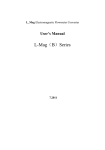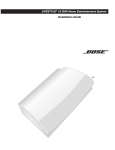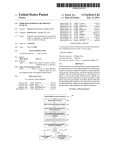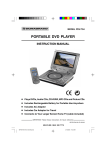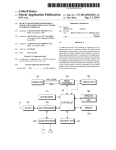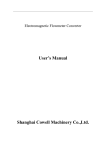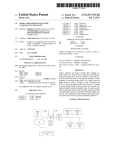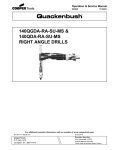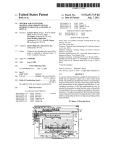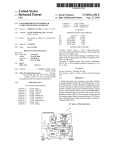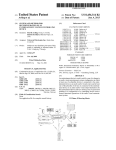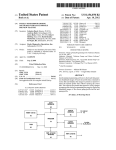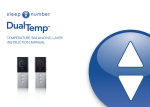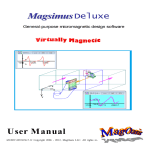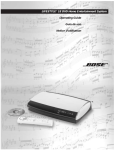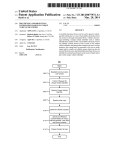Download Video display mode control
Transcript
USOO8698812B2 (12) Unlted States Patent (10) Patent N0.: Callway et al. (54) (75) (45) Date of Patent: VIDEO DISPLAY MODE CONTROL 2002/0163523 A1 * 11/2002 Adachi et a1. ............... .. 345/536 5/2003 Segman Inventors: Edward G. Callway, Toronto (CA); 2003/0161398 A1 * 8/2003 Peder et al' """""" " 375/240'03 David Glen, Toronto (CA); Andrew 2004/0145582 A1* 7/2004 ~Mehta et a1. ................ .. 345/204 (commued) swans Richmond Hill (CA) . . (73) Ass1gnee: ATI Technologies ULC, Markham, OmarlO (CA) Notice: 2005338605 A 12/2005 2006178425 A WO 2006020560 70006 * 2/2006 ............. .. H04N 9/00 Subject to any disclaimer, the term of this OTHER PUBLICATIONS International Search Report for International Application No. PCT/ U'S'C' 154( ) y 814 ays' US2007/017567; from European Patent Of?ce; dated Jan. 18,2008. First Of?ce Action for Chinese Application No. 2007800337850, Appl' NO" 11/833’533 (22) Flled3 ?led Mar. 12, 2009, State Intellectual Property Of?ce of People’s _ Republic of China, Of?ce Action issued Jul. 5, 2010. Aug- 31 2007 (65) Abstract of Chinese Publication No. CN1812511, Jin Renxun Li, Aug. 2, 2006. Prior Publication Data US 2008/0088635 A1 _ _ Primary Examiner * Phi Hoang (60) Provisional application No. 60/835,620, ?led on Aug. 4, 2006. Int- C16061? 15/00 US Cl- (Continued) Apr. 17, 2008 Related U's' APPhcatlon Data (58) JP Patent 15 exlgeltded ordadlusted under 35 (21) (52) FOREIGN PATENT DOCUMENTS JP W0 _ (51) Apr. 15, 2014 2003/0081677 A1 Gruber, Arlington, MA (US); Gaurav Arora, Northborough, MA (US); Philip (*) US 8,698,812 B2 (74) Attorney, Agent, or Firm * Faegre Baker Daniels LLP (57) ABSTRACT A video graphics chip includes a graphics module con?gured to process incoming video information in accordance With different modes to produce a video output signal and to trans mit the video output signal toward a display screen for ren (200601) USPC .......................... .. 345/501; 345/522; 345/581 dering ofvideo corresponding to the video information, and a Field of Classi?cation Search display mode module coupled to the graphics module con USPC .................. .. 725/74; 398/152; 348/ 14.1, 515; 345/204 See application ?le for complete search history. ?gured to analyze the incoming video information to deter mine a type of video associated With the incoming video information and to send a video mode indication of a pre (56) References Cited US. PATENT DOCUMENTS 6,278,478 B1 * 8/2001 Ferriere ..................... .. 348/14.1 6,315,669 B1 11/2001 Okada et a1. 7,620,326 B2 * 11/2009 ferred video processing mode for the incoming video infor mation to the graphics module, Where the graphics module is con?gured to process the incoming video information in accordance With a selected mode from the plurality of differ ent modes based on the video mode indication received from the display module. Glingener ................... .. 398/152 23 Claims, 5 Drawing Sheets 7,636,126 B2* 12/2009 Mallinson 102 104 um US 8,698,812 B2 Page 2 (56) References Cited U.S. PATENT DOCUMENTS 2005/0066066 2005/0099437 2006/0015911 2006/0205507 2006/0227237 2006/0238649 2006/0251389 2007/0115435 3/2005 KaraoguZ et al. 5/2005 Kim et al. 1/2006 Dean ............................. .. 725/74 9/2006 Ho ................................ .. 463/39 10/2006 KienZle et al. ...... .. . 348/343 10/2006 Brown Elliott et al. . 348/441 11/2006 Kim ................. .. 386/83 5/2007 Rosendaal .................... .. 353/30 2007/0223874 A1* 9/2007 Hentschel ..................... .. 386/89 OTHER PUBLICATIONS Second Of?ce Action for Chinese Application No. 200780033785 .0, ?led Mar. 12, 2009, State Intellectual Property Of?ce of People’s Republic of China, Of?ce Action issued Mar. 9, 2011. Japanese Patent Of?ce, “Of?ce Action” mailed Nov. 5, 2013, in related Japanese Application No.: 2009-522902 (partial translation). * cited by examiner US. Patent Apr. 15, 2014 Sheet 1 0f5 US 8,698,812 B2 [10 12 Set Top Box Television Processor GM DMM 16 Mem 14 Game Console 26 24 22 FIG. 1 36 US. Patent Apr. 15, 2014 US 8,698,812 B2 Sheet 2 0f 5 [100 +i 102\ Analyze Control Signal for Video Check for Analog Transmission Artifacts Type l 104—\ f118 l V Check for Manual Override V Check for Parameter /_ 120 Consistency in Incoming Signal I 106\ I V Check for Macrovision l V Check for Gaming Image f 122 Characteristics 132\ Y Y VBI Data 108\ Analyze for 'I‘d'cat'ons 0f —> Processing Mode ‘— Determine Video Video Type A A l Check for DVD Characteristics /_ 124 l Analyze Image 110\ Motion (Scene Analyze IR Input Cuts, Pans) for for Indications of Indications of A A Video Type 112\ Video Type L Analyze Video Render'ng f 126 A Characteristics Analyze Frame A f 128 Cadence Analyze Video/ Relationship 114\ Audio for Indications of A V'deo Type Check for Known Gaming Console} Graphics Chips /_ 130 + Maker Signal Characteristics 116\ Check for RF Modulation and/or Digital Broadcast Artifacts FIG. 2 US. Patent Apr. 15, 2014 Sheet 3 0f5 US 8,698,812 B2 / 150 152 Standard Video or Gaming Mode? Gaming Standard Video 154 158 No No Closed Captioning Average Exceeds Gaming-to-Video Closed Captioning Average Below Video-to-Gaming Threshold for Longer than Gaming Threshold for Longer than to-Video Time? Video-to-Gaming Time? Likely to be f 156 Likely to be Standard Video Gaming Video FIG. 3 f 160 US. Patent Apr. 15, 2014 Sheet 4 0f 5 US 8,698,812 B2 172 170\ IR Signal Likely to be Received? Gaming Video A 176 Game Codes Present? 178 180 X Likely to be Standard Video IR Signals Correlate to Scene Cuts? IR Signals Correlate to Brightness and/or Motion? FIG. 4 f 174 US. Patent Apr. 15, 2014 190\ Sheet 5 0f 5 192\ 194 Initial Video Processing High Quality Mode? 196\ Extra Actions for Long Delay, High Quality Processing i 198\ Further Video Processing FIG. 5 US 8,698,812 B2 US 8,698,812 B2 1 2 VIDEO DISPLAY MODE CONTROL processing delay can be selected for input gaming video. High video rendering accuracy can be set for standard, non gaming, video. CROSS-REFERENCE TO RELATED APPLICATIONS These and other capabilities of the invention, along with the invention itself, will be more fully understood after a review of the following ?gures, detailed description, and This application claims any and all bene?ts as provided by law of US. Provisional Application No. 60/835,620 ?led claims. Aug. 4, 2006 which is hereby incorporated by reference in its BRIEF DESCRIPTION OF THE FIGURES entirety. FIG. 1 is a block diagram of a multimedia entertainment STATEMENT REGARDING FEDERALLY SPONSORED RESEARCH system. FIG. 2 is a block ?ow diagram of a process of determining a video processing mode for a television shown in FIG. 1. FIG. 3 is a block ?ow diagram of a process of determining Not Applicable whether incoming video signals are likely to be for standard video or gaming video based upon amount of closed caption REFERENCE TO MICROFICHE APPENDIX ing information in the signals. Not Applicable FIG. 4 is a block ?ow diagram of a process of determining whether incoming video signals are likely to be for standard video or gaming video based upon correlation of incoming infrared signals and video effects in the signals. BACKGROUND OF THE INVENTION Different forms of video are presently available in today’s society. For example, video can be used for television shows and movies, but also video games. The different forms of video can be processed differently to optimize or improve the presentation of the video, e.g., based on priorities associated with the video forms. For example, for video games, prefer ably a short delay in displaying the video is often desired as FIG. 5 is a block ?ow diagram of a process of processing incoming video signals in accordance with different video 25 processing modes. DETAILED DESCRIPTION OF PREFERRED EMBODIMENTS many video games involve quick and frequent input by a user/player. Conversely, for television shows or movies, a 30 Embodiments of the invention provide techniques for relatively long delay is often acceptable to provide for improved accuracy and/or resolution of the images displayed. selection, especially automatic selection, of video display modes. Incoming signals (e.g., video, audio) can be analyzed The video may be provided by a variety of sources such as for characteristics that can help distinguish different video input, e.g., video games vs. standard video (e.g., television shows or movies). The incoming signals can be analyzed for, e.g., indications of the type of video (e.g., indicated in a cable/satellite boxes, terrestrial broadcast tuners, VCRs, DVD players, game consoles, and computers. Further, video information can be rendered by a variety of devices, including 35 sideband signal), closed captioning, VBI data, watermarks, telephones, music players (e.g., compact disc players, MP3 players, etc.), and televisions. motion (correlated vs. random), horizontal and/or vertical pans, scene cuts, audio/video relationships, broadcast arti Currently, some television sets, e.g., digital television (DTV) sets, support multiple display modes. Such modes 40 include game mode and DVD mode. A user can manually select which mode to use for displaying video content. time, warnings for imminent mode changes, and/ or presence SUMMARY OF THE INVENTION 45 graphics chip including a graphics module con?gured to pro incoming signals. Processing of incoming signals may be 50 mode module coupled to the graphics module con?gured to analyze the incoming video information to determine a type of video associated with the incoming video information and to send a video mode indication of a preferred video process 55 ing mode for the incoming video information to the graphics module, where the graphics module is con?gured to process the incoming video information in accordance with a selected mode from the plurality of different modes based on the video mode indication received from the display module. 60 Various aspects of the invention may provide one or more automatically. A video processing mode may be set manually, including overriding an automatically-set mode. Low video done differently to provide a more desirable video delay versus graphics quality combination. Other embodiments are within the scope of the invention. Referring to FIG. 1, a system 10 can include a set-top box 12, a video game console 14, and a video/audio processing and display device, here a television 16. The set-top box 12 and the game console 14 can be connected to the television 16 to send signals to the television 16. These signals can com prise standard video, e.g., television programs or movies, or video games. Typically, users want low video delay in video games and are willing to sacri?ce video quality for low delay while wanting high quality for standard video such as TV programs or movies, or games with little or no rapid move of the following capabilities. A video processing mode (with corresponding video delay and rendering accuracy) can be set and/ or adjusted in accordance with a type of video received and/ or a user preference. A video processing mode may be set of Macrovision. Automatic selection could be con?rmed, or overridden. Further, characterizations of video game graphics makers can be stored and compared against characteristics of In general, in an aspect, the invention provides a video cess incoming video information in accordance with different modes to produce a video output signal and to transmit the video output signal toward a display screen for rendering of video corresponding to the video information, and a display facts (e.g., RF modulation, digital transmission artifacts such as MPEG encoding, analog transmission artifacts), gaming characteristics, DVD characteristics (e.g., letterboxing), cadences, synch signals, values of video signal portions over ment and for which low video delay is not critical to use of the game. The television 16 can include a processor 18 that can be 65 disposed on a semiconductor chip and that can include memory 20. The memory 20 can store computer-readable, computer-executable code that the processor 18 can read and execute to perform functions described herein to select how to US 8,698,812 B2 3 4 process incoming signals, and to process them accordingly. In ferred processing mode. Con?rmation of the determined video processing mode can be requested from the user. Thus, particular, the processor 18 can include a graphics module 32 for processing video signals for display on a display 36, in for example, if a video game is detected, the user can reject the use of low delay, low video processing if the video game accordance with a current video processing mode. The pro cessor 18 can also implement a display mode module 34 for being played is a slow-moving, high resolution game. The determining, using incoming video/audio signals, control processor 18 can detect the existence of watermarks and analyze whether a watermark relates to a game (e.g., if the watermark corresponds to a watermark known to be associ ated with a game or game manufacturer), and select the appro signals, and/or override signals, which video processing mode to implement. While the set-top box 12 and the game console 14 can be connected to different physical inputs, the signals received from either device 12, 14 may be for video games or other video types at any given time (e.g., because priate processing mode. The processor 18 can analyze the VBI data for closed many video game consoles can also serve as Internet brows captioning, and set the video processing mode for standard ers, play DVDs, etc., and set-top boxes are not limited to video if closed captioning is detected. The processor 18 can be con?gured to determine an average of how much closed providing only non-gaming video, referred to herein as stan dard video). captioning data is present in the incoming signal over time. If The television 16 can be con?gured to automatically deter mine whether incoming signals are for a video, e. g., television the average, determined over a gaming-to-video time, meets or exceeds a threshold for at least a gaming-to-video time, signal, or are for video games. The automatic selection may then the incoming signal is likely (and the processor 18 can be based on one or more of a variety of factors/characteristics indicating what type of video the incoming video is, or is likely to be. 20 to the standard video mode in this case, or to provide a message to the user inquiring as to whether the user desires to The television 16 is further con?gured to select a game or change the video processing mode to standard video mode. gaming video processing mode, or a standard video process ing mode. The gaming mode has a low video delay in order to provide increased responsiveness for processing incoming 25 video gaming signals. The standard video processing mode has a longer video delay and more signal processing (e.g., frame rate conversion) for non-gaming incoming signals, video delay. The processor 18 can be set, e.g., by the user, to either query the user for con?rmation or not. 30 signals through the device 16 to help ensure equivalent audio and video delays, and thus audio/video synchronization. average, determined over a video-to-gaming time, is below a 35 to-video time as portions of standard video may not include closed captioning (e.g., during explosion or chase scenes). 40 delay. user’s manual selection and/or con?rmation of which video delay mode (e.g., high delay high quality versus low delay, 45 The processor 18 can detect motion characteristics of 50 signal to automatically determine whether or not incoming signals are for gaming video where low video delay is desired. The connections between the video sources 12, 14 and the device 16 can include a separate control channel from pro viding control information for use in selecting a video pro cessing mode. The control channel signal can include a spe ci?c indication from the source provider, such as a set-top box 12 or a game console 14, that the incoming signals are, for video processing mode is desirable. The processor 18 can characterize motion according one or more histograms relat ing types of motion and type of video. The processor 18 can determine image pan speed and direction, i.e., horizontal and 55 vertical, and analyze this information in view of a multi dimensional histogram to determine a desired video process ing mode based on the frequency of horizontal and vertical pans over time. The processor 18 further can analyze whether image motion is correlated, with everything in the image moving similarly, or random, with a portion of the image moving differently than another portion. Further analysis of example related to standard video, graphics, or gaming. Also, the control channel signal can provide a warning that the type of video, or at least the desirable video delay mode, is about to change, is changing, or has changed. The device 16 can further be con?gured to analyze the incoming video signals to determine a desired or preferred video processing mode. The processor 18 can detect and gaming mode, using the lack of closed captioning as at least a factor in the determination to change. As with changing from gaming to standard video processing modes, the user can, optionally, be queried as to whether to change video processing modes from standard video to gaming. images provided by the incoming signals to determine which television 16). The television 16 can be con?gured to analyze a sideband Also, the video-to-gaming threshold could be lower than the gaming-to-video threshold. The processor 18 can change to The television 16 can be further con?gured to receive a less processing) to use. This selection/con?rmation can be received via the set-top box 12 or the game console 14 via direct input (e.g., physical selection of a button on the televi sion 16, or selection through a remote control 22 for the video-to-gaming data threshold, then the processor 18 deter mines that the incoming signal could be a video game. The video-to-gaming time is preferably longer than the gaming con?gured to perform a variety of video processing actions, but for lower delay processing modes, to bypass one or more of the processing actions in accordance with the desired The processor 18 can also analyze the VBI data for closed captioning, and set (change to) the video processing mode for gaming video if a lack of closed captioning is detected. If the video mode is standard video, and the closed captioning data delay to help ensure video/ audio synchronization. A user can be advised, e.g., by a message on the device 16, to route audio While the discussion below focuses on two modes, gaming and standard video, as discussed below, more than two video processing modes could be available. The device 16 can be The message to the user could be, e.g., “Non-gaming video has been detected. Would you like to employ non-gaming video processing?” Thus, the message can be more user friendly than asking whether to use a low video delay or a high yielding higher quality images.Audio associated with incom ing signals would be delayed in accordance with the video determine that it is, or is likely) a standard video signal. The processor 18 can be con?gured to either automatically switch analyze portions of the signal, for example, VBI data, water motion can be performed by the processor 18 to determine a frequency of scene cuts, with few scene cuts (low scene cut frequency) indicating a video game and frequent scene cuts indicating standard video. The processor 18 can use the motion characteristics as inputs to a heuristic that indicates, based on the inputs, whether the video is likely to be standard video or gaming video. The heuristic can be developed, e. g., marks, etc. using heuristics to determine the desired or pre by analyzing standard video and gaming video characteristics 60 65 US 8,698,812 B2 5 6 and determining what characteristics and sets of characteris high frequency noise distributed over entire images. The pro tics are more often associated with standard video versus cessor 18 can detect the ringing associated with strong verti gaming video. cal image edges (i.e., signi?cant image differences between The processor 18 can detect a change in video rendering characteristics to determine which video processing mode to use. For example, the processor 18 can determine that when horizontally adjacent image portions). Analog encoding is unable to show strong vertical edges which results in ringing (overshoot in signal value followed by declining error over time on either side of the desired signal value). The processor the device 16 is in “progressive only,” low delay, gaming mode and a non-compliant, interlaced, signal is received, 18 can detect the ringing in the signal as an indication of processor 18 can responsively switch the video processing mode from gaming mode to standard video mode. The processor 18 can detect and analyze relationships standard video. Speckle noise results from interference from a speci?c source and results in very strong noise that is typi cally less widespread over the image than Gaussian noise. between video and audio provided by the incoming signals to The processor 18 can detect speckle noise as an indication of determine which video processing mode is desirable. The standard video. The processor 18 can also detect herring bone processor 18 can characterize the audio-video relationship and compare this with a heuristic that indicates whether the noise, which is also caused by a speci?c interfering source. The processor 18 can detect herring bone noise, e.g., by incoming signal is more likely standard or gaming video. For example, if the incoming signals has ?ashes in the video that monitoring for a speci?c frequency (e.g., using a frequency bank to decompose the signal) pervasively in images over correspond with short, loud noises in the audio (e.g., bangs), then the heuristic will likely indicate that the incoming signal time despite scene cuts, and that appears throughout an image, as an indication of standard video. The processor 18 is further con?gured to detect a loss of synch signal. In a broad cast signal, a loss of a synch signal equates to cuts to com is gaming video for a user-responsive video game (e.g., a 20 police, military, or other gun?re-related game). Further, repetitive background music may indicate that the incoming signal is more likely a gaming signal and thus the gaming mode may be preferred. Background music determination, however, may be combined with another determination before determining that gaming mode processing is pre mercials, etc., while video games typically have a continuous, uninterrupted synch signal. Thus, if a loss of synch signal is 25 detected, the processor 18 can conclude that the incoming video is likely to be standard video. The processor 18 can also monitor parameters of incoming ferred, as slow-moving video games, such as strategy games, video signals to determine whether the incoming video signal may also employ background music, may be preferred to be viewed with standard video processing. monitor blank level, synch tip level, color burst amplitude, The processor 18 can further be con?gured to analyze the is broadcast video or gaming video. The processor 18 can 30 color burst width (indicated by start and end), and setup level. incoming signals for broadcast artifacts. These artifacts If these parameters are constant (e.g., as indicated by a plot include radio frequency (RF) modulation, and digital trans produced by the processor 18), then the processor 18 can conclude that the incoming video is likely to be gaming video. If these parameters are changing (e.g., due to interruption mission artifacts such as MPEG encoding or H.264 encoding. The RF modulation, and MPEG and H.264 encoding artifacts are typically associated exclusively with standard video, and thus if the processor 18 detects any of these artifacts, then the 35 discontinuities), then the processor 18 can concludes that the incoming video is likely to be standard video. The processor 18 is further con?gured to analyze the processor 18 can set the video processing mode to be, or suggest that the video processing mode should be, the stan incoming signals for indicia of gaming video. In particular, dard video mode. The processor 18 can analyze the incoming signals for IPB the processor 18 can look for panning and/or audio/video 40 correlation, zooming, scene cuts, presence of pervasive static image areas (e.g., static during scene changes, pans), sharp frame beat (1 frame, P frame, B frame beat), mosquito noise, blocking artifacts, and/or quantization noise, which are all ness of video, sideband signal provided by game source, associated with MPEG encoding. For the IPB frame beat, the processor 18 can analyze the signals for the periodic (e.g., and/or can measure subcarrier frequency accuracy. Signi? cant panning of images can be associated by the processor 18 with gaming video, as can correlation between audio bursts approximately every 15 frames) drop in quality associated with the periodic generation of a frame from scratch. For mosquito noise, the processor 18 can analyze the signals for and video ?ashes. Frequent zooms and lack of scene cuts can quality degradation (noise) in ?at signal portions adjacent to or more areas of the image are determined to be pervasively also associated by the processor 18 with gaming video. If one edges in the signals. To detect block artifacts, resulting from signi?cant motion in an image and an encoder’s inability to keep up and process completely this motion, can be detected 50 video game and thus appropriate for gaming mode process ing. If the video is relatively sharp, and thus lacking in trans mission artifacts and/ or encoding artifacts that hinder image sharpness, then the processor can determine that the incoming by analyzing relationships of blocks in the image. The pro cessor 18 can analyze the image to determine if blocks in (i.e., portions of) the image fail to align properly by detecting discontinuities between blocks. The block discontinuities can 55 video is likely to be gaming video. The processor 18 can also analyze sideband signals for indicia of gaming video. The produce grid/boundary lines that the processor 18 can detect. Quantization noise occurs where there is a gradual change in the image that is not re?ected within image blocks, but is processor 18 can also measure the subcarrier, used to encode color, frequency accuracy. If the frequency accuracy is very re?ected at the block boundaries, producing abrupt changes where a gradual change should occur. The processor 18 can detect the abrupt image changes at the block edges and deter mine that this is quantization noise and thus an indication that the incoming signal is standard video. The processor 18 can analyze the incoming signals for analog broadcast transmission artifacts of Gaussian noise, static through scene changes and/or pans, then the processor 18 can determine that the incoming signal is likely to be for a 65 high, then the processor 18 can conclude that the signal is standard video while if the frequency accuracy is low, then the processor 18 can conclude that the signal is for gaming. For example, the processor 18 could monitor the variation between an expected frequency and the actual subcarrier fre quency. For example, the processor 18 could compare the number of cycles in the subcarrier frequency over time with a vertical edge ringing, speckle noise, and herring bone noise. system clock in the device 16 over time to determine the The processor 18 can detect Gaussian noise which is random, subcarrier frequency accuracy. US 8,698,812 B2 8 7 to this override signal to select the low-delay mode, here gaming mode, even if the processor 18 has determined that the incoming video signals are standard video signals. An The processor 18 can also be con?gured to analyze the incoming signals for image characteristics indicative of DVDs. For example, the processor 18 can analyze the incom ing signals for the presence of letterboxing, with the signal override could be invoked for purposes other than karaoke. Furthermore, processor 18 can compare characteristics of indicating to put black regions at the top and bottom of the image. If letterboxing is detected, the processor 18 can con clude that the incoming signal is standard video. Further, the processor 18 can analyze the incoming signal for MPEG the incoming signals with characteristics of known game encoding artifacts as discussed above, which are associated makers and graphics device (e. g., graphics cards) makers. console and/ or game graphics device makers. The memory 20 stores characteristics of signals associated with game console with DVD signals. Furthermore, the device 16 can be con?gured such that this The processor 18 can also be con?gured to IR signals 26, 24 from the TV remote 22 and the game console 14, respec tively, through the IR sensor 28. The processor 18 can monitor the IR activity to make decisions regarding the video process ing to be performed. If received IR signals include IR codes known to be from game console controllers (e.g., in accor dance with standards for such signals), then the processor 18 can conclude that the video signals received at the input 15 are information can be stored originally, and/or updated by downloading characteristics and associated content type (e.g., standard video versus gaming video) through a commu nications connection 32, e. g., connected to a communications network such as the Internet. The processor 18 can be con ?gured to determine relevant characteristics of the incoming video signals and compare these with the known characteris tics stored in the memory 20 and conclude that the incoming gaming video signals and thus will implement the gaming mode. The processor 18 can also analyze received IR signals in combination with received video signals to determine cor relation between the IR signals and the video. If commands in the IR signals correspond in time with scene cuts, then the processor 18 can conclude that the incoming IR commands are actuating channel changes, and thus can conclude that the incoming video is likely to be standard video. If commands in the IR signals correlate in time with motion (e.g., panning) or 20 acteristics associated with signals produced by a gaming con sole or game graphics device. 25 scene cuts, then the processor 18 can conclude that the incom 30 sor 18 determines that there is an absence of incoming IR signals over a threshold time, then the processor 18 can con 35 video is, or likely is, gaming video. The processor 18 can also be con?gured to serve as a cadence detector. As a cadence detector, the processor 18 can analyze incoming video signals for patterns related to broad casts, including ?lms and animation. For example, standard video typically has 60 frames per second while animation typically has much fewer than 60 frames per second, as does ?lm, such as 24 frames per second. Thus, if frame rates much lower than 60 frames per second are detected, especially for signi?cant durations (e.g., longer than a threshold such as three seconds), then the processor 18 can conclude that the incoming video should be processed in standard video mode. For gaming video, the video rate sometimes vary due to 40 determine what processing mode to use. The processor 18 can implement the gaming mode if signals are received on the gaming input and can implement the standard video process ing mode if signals are being received on the standard video input. The processor 18 can select which of the two inputs to use, e.g., in response to user override input, if signals are being received on both the gaming input and the standard video input. At stage 102, the processor can analyze a control signal for indications of the input video type. Here, the processor 18 can 45 receive input video signals on a line that is not dedicated to one particular video processing mode. The processor 18 can analyze the control signal, that may be present on the video input line or on a separate control signal line, and can analyze this signal for command indications of a video type. The variances in the time used to render an image, but are often at 60 frames per second 100%, or nearly 100%, of the time, with Initially the processor 18 queries whether there are dedi cated lines for gaming video versus standard video. If there are dedicated inputs for gaming standard video, then the processor 18 does not need to analyze the incoming signals to clude that the incoming video is likely to be gaming video. If the processor 18 detects incoming RF signals at the RF input 30, then the processor 18 can conclude that the incoming In operation, referring to FIG. 2, with further reference to FIG. 1, a process 100 for determining and setting a video processing mode using the system 10 includes the stages shown. The process 100, however, is exemplary only and not limiting. The process 100 may be altered, e.g., by having stages added, removed, or rearranged. brightness (e.g., ?ashes) in the video image, but not often ing video is likely to be gaming video. Further, if the proces signals are likely gaming video signals if the incoming signal characteristics are similar to, or identical to, the stored char short deviations to lower frame rates. Thus, if a frame rate of indication can be, e.g., a bit string that is indicative of one mode versus the other. 60 frames per second is consistently detected, or is detected with lower frequency rates detected for brief durations (e.g., At stage 104, the processor 18 checks for manual override of the default video processing mode or a control-signal 50 indicated video processor mode. The user can select the video less than a threshold such as two seconds, then the processor 18 can conclude that the incoming video should be processed 55 in gaming video mode. 16 to override a default video processor mode implemented by the processor 18 or otherwise indicated by the control signal as determined in stage 102. The processor 18 can cycle The processor 18 can further detect the presence of Mac rovision signals in the incoming video signals. The processor 18 can detect Macrovision-indicative effects such as false pulses and Macrovision-speci?c color burst characteristics, 60 and can conclude that the incoming video signals are likely to be standard video. For example, the processor 18 can be con?gured in accordance with the teachings of Us. Pat. No. to select gaming mode for standard video input signals. The processor 18 can receive an override signal and be responsive through various video processing modes (here, alternating between standard and gaming mode) and ask the user to select or con?rm the desired mode based on displayed images pro duced using the various modes. If an override is received, the 6,356,704 for detecting Macrovision signals. The device 16 can include an override, such as for karaoke, processing mode manually (i.e., direct physical contact with the display 16), or through signals provided to the television processor 18 implements the selected video processing mode 65 regardless of other input indications. At stage 106, if the processor 18 checks for the existence of Macrovision® information on the incoming video signal. If US 8,698,812 B2 10 the processor 18 detects the presence of Macrovision in the information for use in stage 132 to in?uence the likelihood of incoming signal, the processor 18 implements the standard video processing mode. determining that the video processing mode should be stan dard video processing. Further, if the processor 18 determines If at stages 104 or 106, the processor 18 receives or deter mines that there is a manual override selection of the video that the amount of such artifacts are conclusive, then the processor 18 can determine that performance of further stages of the process 100 are unnecessary, although the process 100 could, however, repeat as discussed above. Stage 116 can be performed in a different order/position than as shown in FIG. 2. For example, stage 116 can be processing mode, or that Macrovision information exists in the incoming signal, then the process 100 proceeds to stage 132 where the processor 18 determines the video processing mode and no further stages of the process 100 are preformed. The process 100, however, is re-run periodically even if an override or Macrovision is detected. performed before stage 108, with further stages not pre formed if the RF modulation or digital broadcast artifacts are If the video processing mode is not determined by any of detected, or if artifacts conclusively indicate the appropriate the stages 102, 104, 106, conclusively, then the process 100 proceeds to further stages of the process 100, with informa tion determined at the further stages being provided for fur video processing mode. The process 100 can repeat, e.g., after ther analysis, possibly collectively, for determination of the type changes. video processing mode at stage 132. At stage 108, the processor 18 can analyze the VBI data for indications of video type of the incoming signal. The proces mission artifacts in the incoming video signal. The processor 18 can analyze the incoming signal for, e.g., Gaussian noise, sor 18 can analyze the VBI data for the presence or absence of a threshold amount of time to accommodate or implement the appropriate video processing mode if the incoming video At stage 118, the processor 18 can check for analog trans 20 to-video threshold as determined over a gaming-to-video time, then the processor 18 can set or change the video pro cessing mode to the standard video mode. If the processor 18 vertical edge ringing, speckle noise, and herringbone noise. Again, the processor 18 can indicate that the video processing mode should be the standard video processing mode if the existence of the analog transmission artifacts is conclusive as to the incoming video type. Otherwise, the processor 18 can closed captioning. If closed captioning is found and an aver age amount of closed captioning meets or exceeds a gaming 25 provide information indicating that the input is likely to be determines that the video closed captioning average is below standard video and, and to what degree, or that no or little a video-to-gaming threshold as determined over a video-to At stage 110, the processor 18 analyzes motion in the analog transmission artifacts have been detected. As with stage 116, stage 118 can be performed elsewhere in the pro cess 100, e.g., before stage 108. At stage 120, the processor 120 can check for parameter consistency in the incoming signal. The processor 18 can images corresponding to the video signal for indications of monitor the blank level, synch tip level, color burst amplitude, gaming time, then the processor 18 can set or change the video processing mode to the gaming video mode. Stage 108 is discussed more fully below with respect to FIG. 3. 30 the video type. The processor 18 can analyze the image color burst width, and set up level of the incoming signal. The motion for scene cuts, vertical pans, and horizontal pans. The processor 18 can indicate whether these parameters are con information regarding the image motion such as whether the entire image moves uniformly and the frequency of pans and cuts is provided for further analysis in conjunction with other information to determine at stage 132 what video processing mode should be used. At stage 112, the processor 18 can analyze the video ren dering characteristics to determine which processing mode to 35 video otherwise. At stage 122, the processor 18 can check the incoming signal for gaming video characteristics. The processor 18 can 40 analyze the images of the incoming video signal for panning, audio/video correlation, zooming, scene cuts, presence of pervasive static image areas, sharpness of video, sideband signal, and/or subcarrier frequency accuracy. The processor use. The processor 18 can determine whether the video ren dering characteristics are indicative of progressive only, low delay, gaming mode, or for interlaced processing. The pro cessor 18 can indicate to the user that the video processing stant, with constant parameters indicating that the incoming signal is likely to be gaming video, and likely to be standard 18 can provide information for use in stage 132 for determin 45 ing the video processing mode. This information can include mode should be changed to the standard video mode from the indications of presence and amounts and/ or frequency of such gaming mode or vice versa based on these data. characteristics and whether the image characteristics indicate or suggest that the incoming video signal was likely to be gaming versus standard video. If the video is sharp, the sub At stage 114, the processor 18 analyzes the video and audio relation for indications of the video type. The processor 18 can determine, for example, that small ?ashes in the video correspond with audio bursts and indicate that the incoming 50 scene cuts, and/or pervasive status image areas, then the pro cessor 18 can indicate that the video signal is likely to be video is more likely to be a video game in response to this conclusion. The processor 18 can also look for whether per gaming video and/or provides indicia of such frequencies vasive background music exists and if so indicates that the appropriate video processing mode is likely to be the gaming 55 mode. 60 noise. Depending on the existence of these artifacts, and the amount of the artifacts detected, the processor 18 can provide determine that, the incoming signal is likely to be standard video. At stage 126, the processor 18 can analyze infrared input for indications of video type of the incoming video signal received concurrently with the incoming infrared signal(s). 18 can further analyze the incoming signal for IPB frame beat, mosquito noise, blocking artifacts, and/or quantization and/or other characteristics. At stage 124, the processor 18 can analyze the incoming video signal for DVD characteristics. If the processor 18 ?nds DVD characteristics in the image, the processor 18 can indi cate that, or provide information for use in stage 132 to At stage 116, the processor 18 analyzes the incoming video for RF modulation and/or digital broadcast artifacts. The processor 18 can analyze the incoming signal for indications of RF modulation and MPEG encoding or H.264 encoding. If the processor 18 detects the presence of any of these charac teristics, then the processor 18 can set the video processing mode to the standard video processing mode. The processor carrier frequency accuracy is low, there is frequent panning, audio/video correlation, and/or zooming, and/or infrequent 65 The processor 18 can correlate incoming infrared commands with the video. If the image has scene cuts corresponding with incoming infrared commands, then the processor 18 can pro US 8,698,812 B2 11 12 vide information, for use in stage 132, indicating that the video is likely to be standard video. If the incoming IR signals correlate in time with motion or brightness in the video image amount of closed captioning data on average over a gaming to video threshold time exceeds a gaming to video threshold closed-captioning amount, then the process 150 can proceed to stage 156 and otherwise returns to stage 152. At stage 156, the processor 18 can provide an indication that the incoming video is likely to be standard video which will likely result in the video processing mode being switched to standard video mode at stage 132 of FIG. 2. At stage 158, the processor 18 can analyze the average amount of closed captioning data over a video to gaming threshold time. If the processor 18 determines that the average amount of closed captioning data is below a video to gaming threshold amount for longer than the video to gaming thresh old time, then the process 150 can proceed to stage 160 and otherwise returns to stage 152. At stage 160, the processor 18 can provide an indication that the incoming video is likely to but not scene cuts, then the processor 18 can indicate that the incoming video signal is likely to be gaming video. Stage 126 is discussed more fully below with respect to FIG. 4. At stage 128, the processor 18 can analyze the frame cadence of the incoming video signal. If the processor 18 determines that the incoming video frame rate is at or near 60 frames per second for a large portion of a sample window, then the processor 18 can indicate that the incoming video is likely to be gaming video. If the processor 18 determines that the frame rate is below 60 frames per second for a signi?cant period of time, then the processor 18 can indicate that the incoming video is likely to be standard video. At stage 130, the processor 18 can check for known signal characteristics of gaming console/graphic chips makers. The be gaming video, which will likely result in the video pro cessing mode being set to the gaming mode at stage 132 of processor 18 can analyze the incoming signal to determine characteristics of the signal relevant to characteristics that are associated with particular graphics chips makers or gaming 20 characteristics (e.g., existence and/or values of parameters) with stored sets of characteristics of known/quanti?ed graph ics chips and/or gaming consoles. If the comparison yields high similarity between the analyzed characteristics and a set nal is likely to be standard video or gaming video based on an analysis of incoming IR signals and using the system 10 25 of stored characteristics, then the processor 18 can indicate that the incoming video is likely to be gaming video. At stage 132, the processor 18 can collectively analyze information determined at other stages of the process 100 to determine and set the video processing mode. The various pieces of data can be weighted by the processor 18 and ana 30 35 40 known to be associated with or to be from, game console of the process 100 are conclusive of the incoming video type, then the processor 18 can avoid or omit performing the analy sis of the likelihood indications and implement the video controllers. If such codes exist in the incoming IR signals, then the process 170 can proceed to stage 174, and otherwise The process 100 can repeat to account for changes in the proceed to stage 178. incoming video type. For example, the process 100 can repeat periodically, or anytime when there is a break longer than a threshold amount of time in the incoming signal. Thus, if the At stage 172, the processor 18 can determine whether an IR signal is received. The processor 18 can monitor the IR sensor 28 for indications of incoming IR signals or commands. If no incoming IR signals are indicated by the IR sensor 28, then the process 170 can proceed to stage 174 where the processor 18 can determine that the incoming video is likely to be gaming video and can provide an indication of such. If, how ever, the processor 18 determines that an IR signal is received, then the process 170 can proceed to stage 176. At stage 176, the processor 18 can determine whether game codes are present in the received IR signals. The processor 18 can analyze the incoming IR signals for the presence of codes ing video signal. If any of the analysis done in the other stages processing mode according to the video type conclusively determined at the appropriate stage. includes the stages shown. The process 170, however, is exemplary only at not limiting. The process 170 can be altered, e.g., by having stages added, removed, or rearranged. lyzed to determine whether it is more likely that the incoming video is standard video or gaming video. The processor 18 can set or change the video processing mode to the mode determined to be more likely to be appropriate for the incom FIG. 2. Referring FIG. 4, with further reference to FIGS. 1-2, a process 170 for determining whether an incoming video sig console makers. The processor 18 can compare the relevant 45 At stage 178, the processor 18 can determine whether the incoming IR signals correlate to scene cuts of images in the incoming signal is terminated for longer than the threshold, incoming video signal. If the IR signals, in particular com and then new information is received, then process 1 00 can be mands within those signals, correlate to scene cuts frequently (e.g., channel changes), then the process 170 can proceed to stage 180 where the processor 18 can determine that the incoming video is likely to be standard video and provides an indication of such. If the processor 18 however, determines that the IR signals do not correlate to scene cuts frequently enough, then the process 170 can proceed to stage 182. At stage 182, the processor 18 can determine whether the performed at that time. Referring to FIG. 3, with further reference to FIGS. 1-2, a process 150 for determining and setting a video processing mode based upon presence or absence of closed captioning, e.g., for stage 108 ofFIG. 2, using the system 10 includes the 50 stages shown. The process 150, however, is exemplary only and not limiting. The process 150 can be altered, e.g., by having stages added, removed, or rearranged. 55 At stage 152, the processor 18 can determine whether the current video processing mode is standard video mode or gaming mode. If the processor 18 determines that the current mode is gaming mode, then the process 150 can proceed to stage 154, and otherwise proceed to stage 158. 60 At stage 154, the processor 18 can analyze the VBI data for the existence of closed captioning data above an average amount for longer than a threshold time. The processor 18 can determine whether closed captioning exists within the VBI data and monitors the amount of closed captioning if it does exist. The processor 18 can further average the closed cap tioning data over time. If the processor 18 determines that the 65 incoming IR signals correlate to brightness and/or motion in the video images. If the processor 18 determines that the incoming IR signals, and more particularly commands within the signals, do not correlate to, e.g., ?ashes of brightness, and/or to motion within the video images, then the process 170 can proceed to stage 180. If, however, the processor 18 determines that the IR signals do correlate frequently to brightness (such as ?ashes) and/ or motion of the video images (e.g., panning), then the process 170 can proceed to stage 174. Referring to FIG. 5, with further reference to FIGS. 1-2, a process 190 for processing the incoming video information in a video/audio signal includes the stages shown. The process US 8,698,812 B2 14 13 Further, more video processing modes than just gaming 190, however, is exemplary and not limiting. The process 190 can be altered, e.g., by having stages added, removed, or mode and standard video mode can be available in the display. rearranged. Other modes can be provided with different processing delay and quality tradeoffs. Thus, the display can automatically, or At stage 192, the processor 18 can perform initial video processing on the video information. This initial video pro cessing can include actions to be performed on the video information regardless of the video processing mode in which the processor 18 is operating. At stage 194, an inquiry can made as to the processing mode in which processor 18 is operating. The processor 18 can determine whether the current video processing mode is a low delay, low processing mode or a higher delay, higher processing mode. If the current video processing mode is the the user could manually, choose a desired mode yielding a desired compromise between video processing quality and video processing delay. The display can adjust a frame rate conversion (PRC) algo rithm based upon a selected delay/processing tradeoff. For processing modes with relatively less delay, relatively more conservative FRC decisions can be implemented. For example, for low delay processing modes, drop/repeat FRC could be implemented while at higher delays, a motion-com pensated FRC algorithm could be used. low delay, low video processing mode, then the process 190 The user can be queried to select a video processing mode to, at least initially, associate with an input. The user can select the gaming mode or the standard video mode as a default for a given input to a display. The query can be made, e.g., in response to ?rst detecting information on an input to can proceed to stage 198. If the current video processing mode, however, is a higher delay, higher video processing mode, then the process 190 can proceed to stage 196. At stage 196, the processor 18 can perform additional video processing actions. The processor 18 can perform video processing actions in accordance with the current video pro 20 Further, while the description above refers to “the inven tion,” more than one invention may be disclosed. cessing mode. The processor 18 can implement one or more higher delay, higher video processing modes. At stage 196, What is claimed is: 1. A video graphics chip comprising: the processor 18 can perform the actions appropriate for the current video processing mode. At stage 198, the processor 18 can perform any additional processing actions appropriate for the current video process ing mode. In this stage, the processor 18 can perform actions common to the various video processing modes that are pref erably performed after any video processing actions taken in stage 196. Other embodiments are within the scope and spirit of the appended claims. For example, due to the nature of software, functions described above can be implemented using soft ware, hardware, ?rmware, hardwiring, or combinations of any of these. Features implementing functions may also be the display. a graphics module con?gured to produce a video output signal from an incoming moving video signal compris ing a sequence of different video images and an incom ing audio signal, in accordance with one of a gaming mode and a standard mode, and to transmit said video 30 output signal toward a display screen for rendering of the video images carried in said video output signal, wherein: in said gaming mode, said graphics module is con?gured 35 to produce an enhanced sequence of moving images by executing a ?rst set of processing tasks on the incoming moving video signal; and physically located at various positions, including being dis in said standard mode, said graphics module is con?g tributed such that portions of functions are implemented at ured to produce an enhanced sequence of moving different physical locations. video images by executing a second set of processing tasks on the incoming moving video signal, wherein said second set of processing tasks is larger than said ?rst set of processing tasks, with relatively more The con?guration of inputs to a display, e.g., a television, can be adapted for speci?c types of video. For example, one input to the display for connecting to a game console can be con?gured to have a short delay, with relatively less video processing, while another input for connecting to, e.g., a cable box, can be con?gured to have a longer delay, with relatively more video processing. The con?guration of the inputs can be stored in non-volatile memory in the display. One or both of the inputs can be con?gured to tolerate different types of signals than those expected, or to change signal type, and thus the default delay and processing can be overridden, e.g., by 40 delay; and 45 a display mode module coupled to said graphics module con?gured to analyze said sequence of different video images in said incoming moving video signal to deter mine a type of video associated with said incoming 50 manual input from a user and/ or automatically in response to moving video signal, wherein said determining com prises detecting indicia of gaming video, and to send a video mode indication of a preferred video processing mode for said incoming moving video signal to said graphics module; detection of the video type. The user can be provided with, or allowed to select to see, wherein said graphics module is con?gured to produce said the incoming video rendered using different video processing video output signal in accordance with one of said gam ing mode and said standard mode based on said video mode indication received from said display mode mod ule. 2. The video graphics chip of claim 1, wherein said ana lyZing said sequence of different video images to determine modes. The display can automatically, or in response to a user 55 selection, render the incoming video using gaming mode at one time and using standard video mode at another time. The modes can be cycled repeatedly. The user can evaluate which mode the user prefers, and select that mode such that the display will implement that mode regardless of the type of video. Alternatively, the display can implement the selected mode until the display detects a change in video type. In response to detecting the change in video type, the display can, e.g., automatically change the processing mode as appro 60 priate, query the user as to whether the user desires to change 65 video processing mode, or prompt the user to select to cycle the processing mode and select a desired mode. said type of video associated with said incoming moving video signal further comprises analyZing motion characteris tics of said video images. 3. The video graphics chip of claim 2, wherein said ana lyZing said motion characteristics comprises detecting said motion characteristics and wherein said determining said type of video is based on a heuristic relating motion charac teristics and types of video. US 8,698,812 B2 15 16 4. The video graphics chip of claim 3, wherein said motion of video, a preferred video processing mode from said plurality of different modes for said incoming moving video signal, said processor con?gured to perform rela tively more video processing on said incoming moving video signal, with relatively more video delay, in said characteristics comprise one or more of: frequency of hori zontal panning over time, frequency of vertical panning over time, level of correlation of image motion, frequency of scene cuts, zooming, and presence of pervasive static image areas. 5. The video graphics chip of claim 1, wherein said ana lyzing said sequence of different video images to determine said type of video associated with said incoming moving standard video mode relative to said gaming video mode to provide lower video delay and increased responsive ness for video gaming in said gaming mode. 11. The multimedia entertainment system of claim 10, wherein said analyzing said sequence of different video images to determine said type of video associated with said video signal comprises analyzing relationships between said sequence of different video images carried in said incoming video signal and audio sounds carried in said incoming audio signal. incoming moving video signal further comprises analyzing 6. The video graphics chip of claim 5, wherein said ana lyzing said relationships between said sequence of different video images and said audio sounds comprises characterizing a relationship between said sequence of different video images and said audio sounds and comparing said relation ship with a heuristic relating audio-video relationships and types of video. 7. The video graphics chip of claim 6, wherein said rela tionship between said sequence of different video images and said audio sounds comprises a level of correspondence in 20 wherein said motion characteristics comprise one or more of: frequency of horizontal panning over time, frequency of ver tical panning over time, level of correlation of image motion, frequency of scene cuts, zooming, and presence of pervasive time between video ?ashes and audio bursts. 8. The video graphics chip of claim 1, wherein said graph ics module is further con?gured to process incoming infrared signals, and said analyzing said sequence of different video images to determine said type of video associated with said 25 incoming moving video signal further comprises analyzing to said at least one audio input and is further con?gured to 30 incoming infrared signals. video associated with said incoming moving video signal comprises analyzing relationships between said video images 35 dence in time between infrared signals and motion, corre and absence of incoming infrared signals over a threshold sequence of different video images and said audio sounds 40 at least one video input con?gured to receive an incoming moving video signal comprising a sequence of different video images; a display con?gured to render video images; and a processor coupled to the at least one video input, and to 45 the display, the processor con?gured to produce a video output signal from an incoming moving video signal comprising a sequence of different video images in accordance with one of a gaming mode and a standard mode, and to transmit said video output signal to the display for rendering of said sequence of different video carried in said incoming moving video signal and audio sounds carried in said incoming audio signal. 15. The multimedia entertainment system of claim 14, wherein said analyzing said relationships between said spondence in time between infrared signals and video ?ashes, time during which video images are displayed. 10. A multimedia entertainment system comprising: process said incoming audio signal, and said analyzing said sequence of different video images to determine said type of 9. The video graphics chip of claim 8, wherein said rela tionship between said sequence of different video images and said audio sounds comprises one or more of: correspondence in time between infrared signals and scene cuts, correspon static image areas. 14. The multimedia entertainment system of claim 10 fur ther comprising at least one audio input con?gured to receive an incoming audio signal, wherein said processor is coupled relationships between said sequence of different video images carried in said incoming moving video signal and said motion characteristics of said video images. 12. The multimedia entertainment system of claim 11, wherein said analyzing said motion characteristics comprises detecting said motion characteristics and wherein said deter mining said type of video is based on a heuristic relating motion characteristics and types of video. 13. The multimedia entertainment system of claim 12, 50 comprises characterizing a relationship between said sequence of different video images and said audio sounds and comparing said relationship with a heuristic relating audio video relationships and types of video. 16. The multimedia entertainment system of claim 15, wherein said relationship between said sequence of different video images and said audio sounds comprises a level of correspondence in time between video ?ashes and audio bursts. 17. The multimedia entertainment system of claim 10 fur ther comprising at least one infrared input con?gured to receive incoming infrared signals, wherein said processor is images by the display, wherein: coupled to said at least one infrared input and is further in said gaming mode, said processor is con?gured to produce an enhanced sequence of moving images by con?gured to process said incoming infrared signals, and said analyzing said sequence of different video images to deter mine said type of video associated with said incoming video executing a ?rst set of processing tasks on the incom 55 ing moving video signal; and signal further comprises analyzing relationships between said sequence of different video images carried in said incoming in a standard mode, said processor is con?gured to pro duce an enhanced sequence of moving video images by executing a second set of processing tasks on the incoming moving video signal, wherein said second moving video signal and said incoming infrared signals. 60 18. The multimedia entertainment system of claim 17, wherein said relationship between said sequence of different set of processing tasks is larger than said ?rst set of video images and said audio sounds comprises one or more processing tasks, with relatively more delay; of: correspondence in time between infrared signals and scene cuts, correspondence in time between infrared signals and motion, correspondence in time between infrared signals and video ?ashes, and absence of incoming infrared signals wherein the processor is con?gured to analyze said sequence of different video images to determine a type of video associated with said incoming moving video 65 signal, wherein said determining comprises detecting over a threshold time during which video images are dis indicia of gaming video and to select, based on said type played. US 8,698,812 B2 17 18 20. The method of claim 19, Wherein said analyzing said video images to determine said type of video associated With 19. A method of processing video information, said method comprising: receiving an incoming moving video signal comprising a said incoming moving video signal further comprises detect sequence of different video images and an incoming ing motion characteristics of said video images and determin audio signal at a video display device from a video ing said type of video based on a heuristic relating motion characteristics and types of video. 21. The method of claim 20, Wherein said motion charac source; analyzing video images carried in said incoming moving teristics comprise one or more of: frequency of horizontal video signal to determine a type of video associated With selecting, based on said analyzing, one of a gaming mode and a standard mode for producing a video output signal comprising a sequence of different video images; and panning over time, frequency of vertical panning over time, level of correlation of image motion, frequency of scene cuts, zooming, and presence of pervasive static image areas. 22. The method of claim 19, Wherein said analyzing said video images to determine said type of video associated With producing a video output signal in accordance With the selected one of said gaming mode and said standard a relationship between said video images and audio sounds said incoming video signal, Wherein said determining comprises detecting indicia of gaming video; and said incoming moving video signal comprises characterizing carried in said incoming audio signal and comparing said mode; relationship With a heuristic relating audio-video relation Wherein said producing comprises: in a gaming mode, producing an enhanced sequence of moving images by executing a ?rst set of processing tasks on the incoming moving video signal; and 20 in a standard mode, producing an enhanced sequence of to determine said type of video associated With said incoming moving video images by executing a second set of processing tasks on the incoming moving video sig nal, Wherein said second set of processing tasks is larger than said ?rst set of processing tasks, With relatively more delay. ships and types of video. 23. The method of claim 19, further comprising receiving incoming infrared signals at said display device from an infrared signal source; and said analyzing said video images moving video signal further comprises analyzing relation 25 ships between said video images carried in said incoming moving video signal and said incoming infrared signals. * * * * *
















